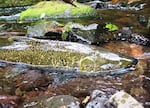
OSU researchers gathered lineage data about a local population of Chinook salmon for over 13 years.
Courtesy of Oregon State University
Researchers at Oregon State University say new discoveries about how some Chinook salmon breed could help guide conservation efforts.
When salmon from a hatchery breed in nature, they produce fewer adult offspring than their wild-born peers. And researchers aren’t certain why.
However, in a new study of Chinook salmon from a McKenzie River tributary, the wild-born offspring of those hatchery fish appeared not to inherit their parents’ poor reproductive fitness.
“Our findings suggest that fitness may improve in the wild as quickly as it declines in the hatchery,” said OSU associate professor Kathleen O’Malley, the study’s senior author.
O’Malley said it’s unclear if the increase is caused by genetics, environmental factors, or a combination of both. And she said hatchery-born salmon may still pose reproductive risks to the wild populations they breed with and their offspring.
Additionally, O’Malley said other salmon populations will need to be studied before researchers can draw wide-reaching conclusions from this data.
However, she said these findings support the idea that hatchery salmon could help sustain or repopulate wild populations in the future.
Under the Endangered Species Act, spring Chinook salmon in the Upper Willamette Valley are a “threatened evolutionarily significant unit.”